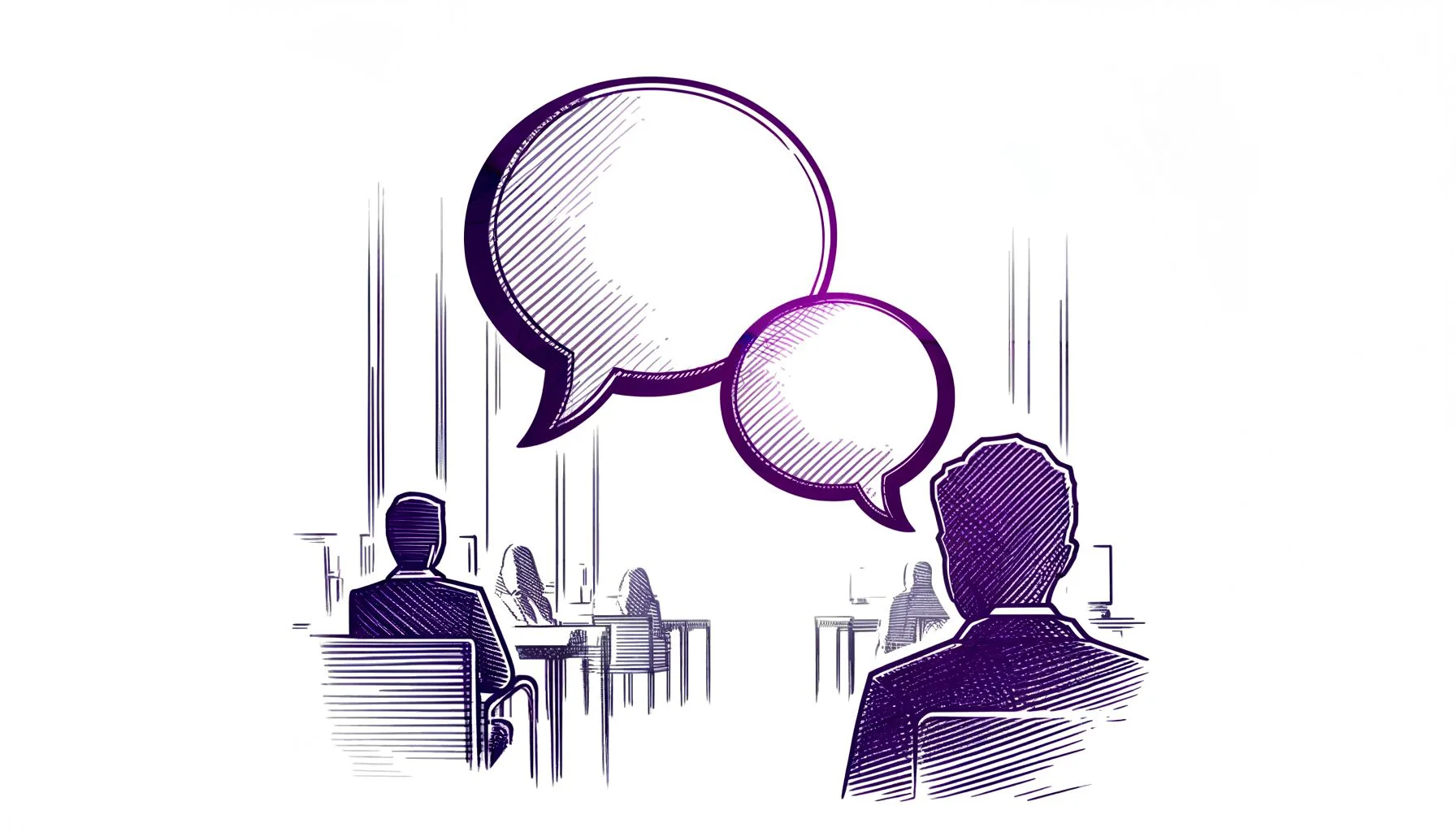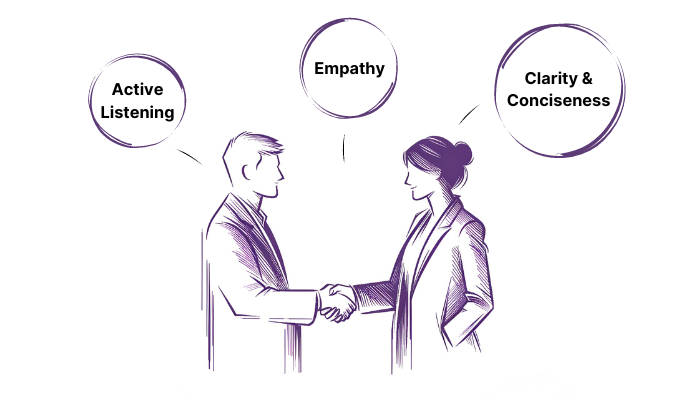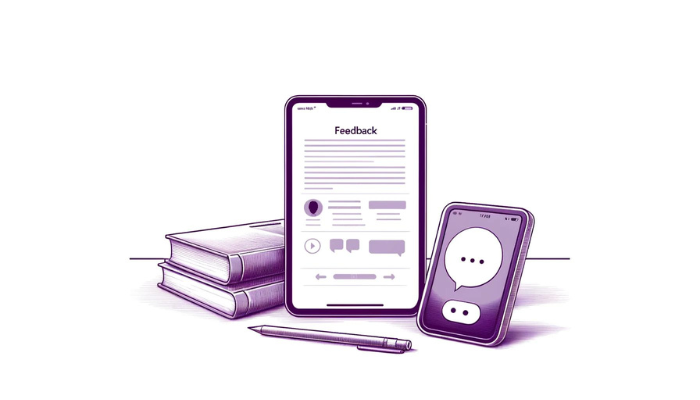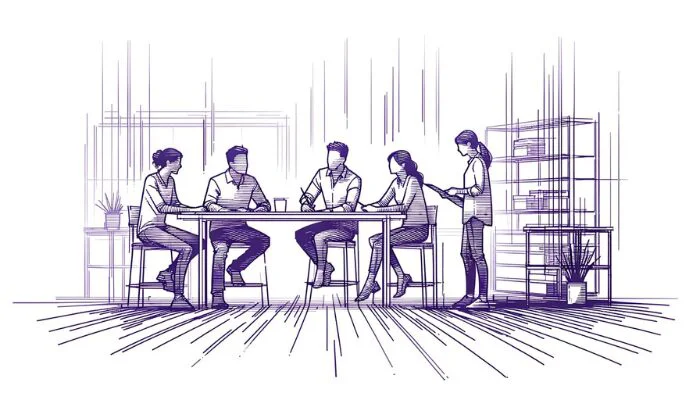How to: Effective Communication in the Workplace
A key ingredient for success in business

In the dynamic and digital-centric modern workplace, adept communication transcends a mere soft skill – it becomes a fundamental component for the prosperity of any organization.
It facilitates the smoothing of daily workflows and fortifies team resilience, turning potential obstacles into catalysts for development and creativity.
In this article we explore the subtleties of communication within the workplace, providing practical advice and strategic insights to improve interaction and cooperation.
This article will give you:
✅ an idea of the core skills for effective communication
✅ strategies to improve communication in the workplace
✅ ways to adapt to different communication situations
Importance of communication in the workplace
Communication in the workplace transcends the simple exchange of information between colleagues. It is about building relationships, ensuring everyone is on the same page, and fostering an atmosphere where ideas and feedback can flow freely. Effective communication is not just beneficial but essential across various facets of a professional environment, including:
- Leadership and management: Effective leaders use communication to inspire and guide their teams. Clear directives and open feedback channels enhance performance and align goals.
- Team collaboration: In an era where teamwork is paramount across most sectors, the ability to communicate clearly and effectively determines the success of collaborative efforts.
- Customer relations: The quality of communication can directly impact customer satisfaction and loyalty. Transparent and effective communication ensures that customer needs are met promptly and efficiently.
- Conflict resolution: Effective communication is key to resolving disputes and preventing potential issues from escalating, maintaining a harmonious work environment.
The effectiveness of communication in successful companies
The correlation between effective communication and business success is well-documented through various studies and research findings. The following statistics underscore the value of good communication practices:
- Increased productivity: According to a study by Towers Watson, companies with highly effective communication practices see 47% higher returns to shareholders compared to those with less effective communication.
- Employee engagement: Gallup reports that businesses with effective communication are 3.5 times more likely to outperform their competitors. Furthermore, their research indicates that clear communication is one of the key drivers of employee engagement.
- Reduction in errors: A study from the Holmes Report found that poor communication can cost large companies an average of $62.4 million per year due to misunderstandings and information gaps.
- Improved project outcomes: The Project Management Institute (PMI) reveals that ineffective communication is a primary contributor to project failure one-third of the time and had a negative impact on project success more than half the time.

Fundamentals of workplace communication
Effective communication in the workplace is a critical business tool that facilitates clear understanding and fosters a productive work environment. We now delve into the essence of what makes communication effective and explore the different types that are pivotal in any professional setting.
Definition of effective communication
Effective communication occurs when the sender and the receiver of a message understand the message and its intent in the way it was intended. This process is successful only when both the transmitter of the message and the recipient understand the meanings of the message similarly. Here are the key components that constitute effective communication:
- Clarity and conciseness: The message should be clear and to the point, without unnecessary jargon or complex language that might confuse the receiver.
- Accuracy: Information provided should be accurate and factual, avoiding misunderstandings or the spread of misinformation.
- Feedback: Effective communication involves not just sending but also receiving feedback to ensure the message has been understood correctly and to foster ongoing dialogue.
- Empathy: Communicators should consider the emotions and perspectives of the receiver, adapting their messages to be received more positively.
- Engagement: The communication should be engaging and attention-catching, making it more likely that the information will be remembered and acted upon.
Types of Communication
Understanding the various forms of communication is essential to apply them effectively in professional settings. There are three primary types of communication that play a vital role in the workplace:
1. Verbal communication
- In-Person meetings: Allows for immediate feedback and adjustment of the message based on verbal and non-verbal cues.
- Phone calls and video conferences: Useful for remote communication, relying heavily on tone and clarity of voice.
2. Non-Verbal communication
- Body language: Includes facial expressions, body posture, and gestures, which can convey confidence, openness, or, conversely, disinterest or disagreement.
- Eye contact: Maintaining appropriate eye contact improves the connection between communicators and signals attention and respect.
- Physical distance (Proxemics): The space between communicators can affect how the message is received, influencing perceptions of authority or intimacy.
3. Written communication
- Emails: Common in nearly all business settings, effective for delivering clear and concise messages and for documentation.
- Reports and documents: Essential for detailed and formal communication that requires record-keeping and thorough review.
- Instant Messaging and texts: Useful for quick, informal communication that requires immediate attention or response.

Core skills for effective communication
Effective communication in the workplace is built on several foundational skills. Among these, active listening, clarity and conciseness in verbal exchanges, and the ability to empathize are paramount.
The importance of active listening
Active listening is more than just hearing the words spoken by others; it is about fully comprehending the information being shared, engaging with it, and responding thoughtfully. Active listening is essential because it:
- Builds trust: Demonstrates respect and value for the speaker, fostering a supportive communication environment.
- Enhances understanding: Helps in accurately receiving and interpreting messages, reducing the likelihood of misunderstandings.
- Facilitates conflict resolution: By truly understanding all sides of a conversation, more effective solutions can be found.
Tips for improving active listening:
- Maintain eye contact: Shows attentiveness and interest.
- Avoid interrupting: Allow the speaker to finish their thoughts without interjection.
- Ask clarifying questions: Ensures understanding and shows engagement.
- Repeat back what you heard: Offers a chance to confirm that your understanding is correct.
- Mind your body language: Adopt an open posture and nod where appropriate to show attentiveness.
Clarity and conciseness in verbal communication
Clear and concise communication is essential to efficiency in the workplace. It helps in minimizing errors and ensures that messages are not only received but understood and acted upon correctly.
Why it matters:
- Saves time: Direct and straightforward communication takes less time than overly complex or vague messaging.
- Reduces errors: When instructions are clear, the chance of mistakes is lowered.
Strategies to enhance clarity and conciseness:
- Plan your message: Think about what you need to communicate before you speak.
- Be direct: Avoid roundabout phrasing and get to the point quickly.
- Use simple language: Avoid jargon and technical terms unless absolutely necessary.
- Employ visuals: Where possible, use diagrams, charts, or images to clarify complex points.
Empathy: Understanding Emotional Undertones
Empathy in communication involves recognizing, understanding, and appropriately responding to the emotions of others. It’s crucial for:
- Promoting teamwork: Helps in building stronger, more collaborative teams.
- Enhancing leadership: Leaders who show empathy are typically more respected and effective.
- Improving Customer Relations: Empathy leads to better service and customer satisfaction.
Ways to Develop Empathy:
- Active listening: As noted above, listen to understand, not just to respond.
- Acknowledge feelings: Recognize and validate the emotions of others in your responses.
- Practice perspective-taking: Try to see situations from the point of view of your colleagues or clients.
- Respond appropriately: Tailor your responses based on the emotional cues you have gathered.

Strategies to improve communication
Improving communication in the workplace is crucial for enhancing productivity and building a more engaged team. This section outlines strategies that can be employed to enhance communication skills within an organization, including training, effective feedback mechanisms, and leveraging technology.
Training and workshops on communication skills
Investing in communication training and workshops is a direct approach to enhancing interpersonal skills among employees. These training sessions can cover various aspects of communication:
- Active listening: Workshops can provide exercises that improve listening skills, essential for understanding and cooperation.
- Conflict resolution: Teaching employees how to handle conflicts gracefully can prevent minor disagreements from escalating into bigger problems.
- Public speaking and presentation skills: Enhancing these skills helps in delivering clearer and more effective messages in meetings and presentations.
Benefits of communication training:
- Improved employee efficiency: Clear communicators can relay their ideas and instructions more effectively, reducing the time needed to complete tasks.
- Enhanced team collaboration: Teams that communicate effectively are more likely to achieve their goals smoothly and efficiently.
- Increased job satisfaction: Employees who feel heard and understood are generally happier and more content in their jobs.
The role of feedback: Giving and receiving
Feedback is a cornerstone of effective communication and plays a vital role in personal and organizational growth. Here’s how feedback should be approached:
- Constructive feedback: Focus on providing feedback that is constructive and aimed at helping the recipient improve, rather than just critiquing.
- Timeliness: Offer feedback soon after the relevant event to ensure it is relevant and meaningful.
- Regular reviews: Implementing regular one-on-one meetings between employees and their managers can help maintain open lines of communication and provide regular opportunities for feedback.
Creating a feedback-rich environment:
- Encourage a Two-Way Street: Promote an environment where employees feel comfortable giving feedback to their peers and superiors (easily done with online forms apps).
- Training on feedback techniques: Provide training that teaches employees how to give and receive feedback effectively and respectfully.
- Recognize and reward: Acknowledge employees who use feedback constructively to improve their performance or the workplace environment.
Using technology to foster effective communication
Technology, when used correctly, can greatly enhance communication within a workplace. Here are some ways to integrate technology into daily communications:
- Project Management software to track progress and communicate updates ensures everyone is aligned on project goals and deadlines.
- Chat Apps can help maintain personal connections, especially in remote or hybrid work environments.
Best Practices for using technology:
- Training on tools: Ensure all employees are trained on how to use communication technologies effectively.
- Establish clear protocols: Set guidelines for when and how different communication tools should be used.
- Evaluate and adapt: Regularly assess the effectiveness of communication tools and make adjustments as necessary to meet the evolving needs of the organization.

Adapting to different communication situations
Effective communication in the workplace requires adaptability to various contexts and scenarios. Whether it’s through team meetings, one-on-one interactions, or digital channels, each situation demands specific strategies to enhance clarity and effectiveness.
Team communication: Meetings and group work
Meetings and group projects are fundamental for team collaboration. Here’s how to ensure communication is effective in these settings:
- Preparation: Provide an agenda before meetings to give participants an overview of topics to be discussed. This allows everyone to prepare and contribute meaningfully.
- Roles assignment: Assign roles such as timekeeper, note-taker, and facilitator to keep the meeting structured and efficient.
- Inclusive participation: Encourage participation from all members, ensuring a diversity of perspectives and ideas.
- Follow-up: Distribute meeting minutes and action items afterward to reinforce responsibilities and deadlines.
Tips for effective group communication:
- Use round-robin techniques to ensure everyone has a chance to speak.
- Establish ground rules for discussions to prevent domination by more vocal members.
- Utilize visual aids like charts or slides to clarify complex points.

Bring the group communication at your workplace to the next level.
Get started for free now.
One-on-one interactions: Employee reviews and feedback sessions
Personal interactions such as performance reviews or feedback sessions are crucial for individual development and maintaining open lines of communication between supervisors and their teams.
- Structured format: Use a consistent format for reviews to ensure that all necessary topics are covered and that the employee knows what to expect.
- Goal-oriented discussions: Focus on specific goals and objectives, providing clear examples and actionable feedback.
- Two-way dialogue: Encourage employees to share their thoughts and concerns, making the session a two-way conversation.
Enhancing one-on-one communication:
- Prepare in advance, noting key points you want to discuss.
- Be empathetic and open to understanding the employee’s perspective.
- Set follow-up meetings to review progress on discussed points.
Digital communication: Emails, Messaging tools
Digital tools are integral to modern business communication, facilitating rapid information exchange. However, it’s essential to use them appropriately to maintain professionalism and effectiveness.
- Email communication:
- Clarity and brevity: Keep emails concise and to the point. Long, rambling emails can dilute the message and lead to confusion.
- Subject lines: Use informative subject lines that clearly state the purpose of the email.
- Professional tone: Maintain a professional tone, even in quick replies.
- Messaging tools:
- Immediate needs: Reserve instant messaging for conversations that require quick responses or for informal communication.
- Status updates: Use tools like Zenchat for quick updates or informal check-ins that don’t require a full email.
Best Practices for digital communication:
- Choose the right medium for the message – don’t discuss sensitive issues over casual platforms.
- Regularly update communication protocols to reflect new digital tools and uses.
- Train employees on digital etiquette, emphasizing the importance of thoughtful and respectful online interactions.

Final Thoughts
Mastering effective communication in the modern workplace is not just about exchanging information, but about cultivating a rich, productive environment where ideas can thrive and relationships can flourish.
Whether through improving active listening, embracing empathy, or harnessing technology, each strategy discussed provides a stepping stone towards transforming everyday interactions into a powerful tool for business success.
As we move forward, let us remember that the quality of our communication profoundly influences our collective and individual achievements. By applying these insights, we can all contribute to a more engaged, efficient, and understanding workplace.
What are your ways of improving communication in the workplace? As always, we’d love to hear your thoughts.
Until next time,
Jessica and the Zenkit team
FREE 20 MIN. CONSULTATION WITH A PROJECT MANAGEMENT EXPERT
Wanna see how to simplify your workflow with Zenkit in less than a day?
Book a Live Demo